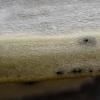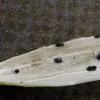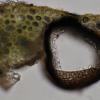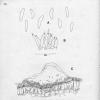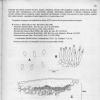
08-12-2025 18:59
 Lothar Krieglsteiner
Lothar Krieglsteiner
.. found by a seminar-participant, I do not know t

08-12-2025 21:04
Mark Stevens"Hello everyone,I'm relatively new to microscopy (

08-12-2025 17:37
 Lothar Krieglsteiner
Lothar Krieglsteiner
20.6.25, on branch of Abies infected and thickened

07-12-2025 16:07
Arnold BüschlenHallo, ich habe in einer Moos-Aufsammlung (epiphy

16-03-2014 22:00
Hello,I found this species a few months ago but ha

08-12-2025 13:39
Thomas Læssøehttps://svampe.databasen.org/observations/10572899

05-12-2025 17:33
 Bruno Coué
Bruno Coué
Bonjour, je serais heureux de recueillir votre avi
Coelomycete on Marram
Chris Johnson,
02-01-2015 21:26
Struggling to identify this coelomycete on the flower-sheaths of Marram (Ammophila arenaria).
Quite numerous, apothecia largely immersed, black: averaging 250 µm wide by 170 µm tall.
Spores hyaline, smooth, quite pointed and pinched at one end: 8.5-14.3 x 4.5-6.5 µm.
Does anyone know of a key to coelomyctes?
Any help welcome, as usual.
Cordialement,
Chris
Martin Bemmann,
03-01-2015 13:55
Chris Johnson,
03-01-2015 16:20
Re : Coelomycete on Marram
Hi Martin
Thank you for looking at this for me.
I don't have any images of the conidiophores.
My concern is that the conidia of Rhodesia subtecta are rather narrow. Sutton (1980), 5-7 x 2.5; Grove (1937), 12-14 x 2 and Ellis & Ellis (1997), 5-7 x 2-3.
Also, two of the authors give peak season as July - August.
I'm make a fresh collection and see if I can provide some additional information.
Regards, Chris
Thank you for looking at this for me.
I don't have any images of the conidiophores.
My concern is that the conidia of Rhodesia subtecta are rather narrow. Sutton (1980), 5-7 x 2.5; Grove (1937), 12-14 x 2 and Ellis & Ellis (1997), 5-7 x 2-3.
Also, two of the authors give peak season as July - August.
I'm make a fresh collection and see if I can provide some additional information.
Regards, Chris
Chris Yeates,
03-01-2015 17:36

Re : Coelomycete on Marram
I too had ruled out the Rhodesia on spore dimensions.
regards
Chris
regards
Chris
Dartanha Soares,
07-01-2015 14:52

Re : Coelomycete on Marram
Hi Chris,
Despite the spores size, Rhodesia is an acervular coelomycetes, and your specimen clearly forms pycnidia. So the genus Rhodesia is really out of the rule.
Unfortunately without "see" the conidiogenesis any attempt to identify this fungus will be a "shot in the dark", unless someone here in the forum already found it.
I recommend you to check Sutton's monograph but you really need clarify the conidiogenesis. Because there are several pycnidial coelomycetes with non septated hyaline conidia.
You can also check for any kind of extracellular appendage, like a mucilaginous sheath or cap, in the conidia (but I'm afraid your fungus has none), in this case NagRaj's monograph will be more useful.
Despite the spores size, Rhodesia is an acervular coelomycetes, and your specimen clearly forms pycnidia. So the genus Rhodesia is really out of the rule.
Unfortunately without "see" the conidiogenesis any attempt to identify this fungus will be a "shot in the dark", unless someone here in the forum already found it.
I recommend you to check Sutton's monograph but you really need clarify the conidiogenesis. Because there are several pycnidial coelomycetes with non septated hyaline conidia.
You can also check for any kind of extracellular appendage, like a mucilaginous sheath or cap, in the conidia (but I'm afraid your fungus has none), in this case NagRaj's monograph will be more useful.
Chris Johnson,
07-01-2015 15:11
Re : Coelomycete on Marram
Hi Soares
Thank you for giving some thought to this fungus. I have been through Groves, Sutton and Ellis & Ellis without success, but agree I needs some more details. I'm not familiar with NagRaj's monograph.
I tried to make a fresh collection this week but failed to find the fungus again. We have a lot of Marram here so will try again at a new site.
Regards, Chris
Thank you for giving some thought to this fungus. I have been through Groves, Sutton and Ellis & Ellis without success, but agree I needs some more details. I'm not familiar with NagRaj's monograph.
I tried to make a fresh collection this week but failed to find the fungus again. We have a lot of Marram here so will try again at a new site.
Regards, Chris
Dartanha Soares,
07-01-2015 16:22

Re : Coelomycete on Marram
Hi Chris,
Here is the reference of Nag Raj's Monograph:
Nag Raj TR. 1993. Coelomycetous anamorphs with appendage-bearing conidia. Mycologue Publications: Waterloo, Canada. 1101 pp.
Good luck.
Here is the reference of Nag Raj's Monograph:
Nag Raj TR. 1993. Coelomycetous anamorphs with appendage-bearing conidia. Mycologue Publications: Waterloo, Canada. 1101 pp.
Good luck.
Chris Johnson,
07-01-2015 17:50
Re : Coelomycete on Marram
Many thanks Dartanha, I will look into it. Sorry I got your name reversed in the last message.
Best wishes, Chris
Best wishes, Chris
Dartanha Soares,
07-01-2015 18:38

Re : Coelomycete on Marram
Hi Chris, in fact, I mistakenly had put my name in reverse order when I filled my profile, and thanks to you I noticed that! :)
In case you notice any kind of appendage I can try to scan the synoptic key from Nag Raj' monograph.
In case you notice any kind of appendage I can try to scan the synoptic key from Nag Raj' monograph.
Chris Johnson,
07-01-2015 20:53
Re : Coelomycete on Marram
Hi Dartanha
There are no appendages on the first collection but I will pursue it and try to find some more material. It won't be for a few days as we are expecting 170kph winds! Isn't it possible to scan for NO appendages?
Thank you for the offer, I will hopefully come back with better details.
Chris
There are no appendages on the first collection but I will pursue it and try to find some more material. It won't be for a few days as we are expecting 170kph winds! Isn't it possible to scan for NO appendages?
Thank you for the offer, I will hopefully come back with better details.
Chris
Dartanha Soares,
08-01-2015 17:59

Re : Coelomycete on Marram
I sent it to your e-mail.

